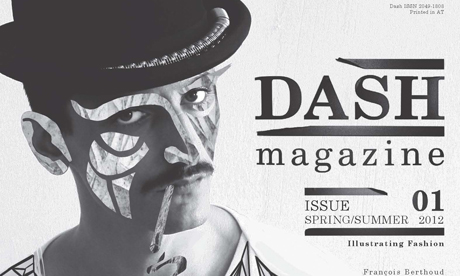Hackney-based magazine makes DASH for fashion

More haste: DASH magazine
It is a Wednesday, and unusually for Vyner Street (known for its monthly Thursday evening private views) a generous crowd has formed outside the Degree Art gallery. Inside the sparse white space, an array of illustrative art hangs on the walls, DJ Erol Sabadosh spins tunes in the corner, vodka flows from the bar and suspended in the centre, from upon high, are the dark matt pages of a thick new publication.
The crowd is here to celebrate the launch of DASH magazine, an illustrated fashion magazine that weaves its chosen art form into the very fabric of the publication. Illustrations are not just margin-fillers here, but are boldly splashed about, communicating meaning in their paint strokes and acting on a par with the features and interviews that make up the text.
DASH is the brainchild of NoéMie Schwaller, Swiss-born and now residing in Dalston. Schwaller recently completed her MA in fashion journalism at London College of Fashion and won the Best Fashion Journalism Award for her efforts. With a good team around her she has gone on to launch DASH, timing it to coincide with February’s London Fashion Week.
In her opening article NoéMie writes about fashion illustration and art theory. “The intention here is not to deconstruct fashion illustration but to accept it as a new whole, containing all these signs of fashion, in context.
“Commercial or not, fashion illustration is in itself a celebration of artifice, combining visual seduction with social statements.”
The result of NoéMie’s vision is a cultural, and visually diverse, journey through fashion from photo shoots to interviews with musicians and artists. The magazine is peppered throughout with accomplished illustrations from a host of international and London-based illustrators. One of the strongest features is an illustrated editorial of spring’s most coveted handbags by illustrator Patrick Morgan. Kenzo and Prada bags are recreated in splatters of lively yellow and pink ink, completely turning on its head the highly-staged and re-touched treatment these products usually receive in official advertising.
Another success is the street style feature that offers both traditional street style photography as well as illustrator Spiros Halaris’ interpretations of the images. Hilaris, like many of the other illustrators, is based here but hails from overseas, offering both an international and localised approach to the publication.
The combination of text, photography and illustration makes for a rich aesthetic with a satisfying matte finish, although at times there is so much of everything that the structure gets buried. Launching a brand new publication now, as print media becomes increasingly threatened by the realities and possibilities of the internet, is a bold move; but NoéMie is not fazed: “There are loads of people who appreciate nice prints and prefer it to online publication, because colour and quality changes on screen. Print is and will always be beautiful.”
